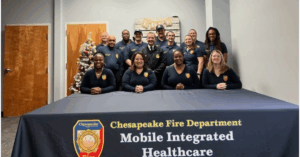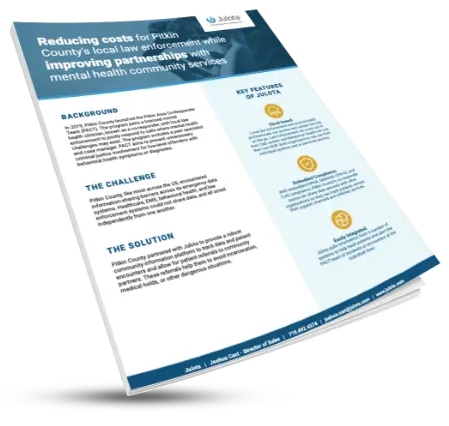These aren’t isolated “dispatch logs”; they are the kinds of cases the Chesapeake Fire Department’s Mobile Integrated Healthcare program set out to change in January 2020. Under Jo Phillips’s leadership, the MIH program expanded beyond emergency response. Its Fall Prevention Program alone has slashed fall-related 911 calls by 60%, freeing up emergency crews for more critical missions.
That’s why Jo Phillips insists MIH-CP isn’t a “nice-to-have” or a pilot, it’s essential. She works with programs through her own venture, Integrated Healthcare Solutions, to ensure vulnerable populations are cared for and on September 30th, she’ll be digging how MIH-CP programs are built in Listening to My Community: Why Do We Need an MIH-CP?
If you wish to register for that session: Click Here
To see the full interview I conducted with Jo, read on!

Q: Looking back, what combination of systemic shortcomings, personal insights, and professional motivations led you to feel called to create Integrated Healthcare Solutions, and how did that sense of urgency translate into your vision for more connected and effective models of care delivery?
A: Honestly, it started with seeing firsthand how broken community healthcare systems are and how much they affect patient outcomes. You feel like people are getting lost in the system, and it’s not because of lack of effort — it’s because the systems don’t talk to each other. I felt a strong calling to create a more connected, patient-centered approach that bridges the gaps among providers, services, and support networks. This passion led me to develop a consulting platform focused on innovative integration strategies—aimed at helping communities deliver healthcare that is seamless, effective, and compassionate.
Q: What steps did you take to ensure Chesapeake’s MIH program would continue to thrive after you retired?
A: That was really important to me. When I started, MIH-CP was still in its infancy, and for a long time it felt like I was building something from scratch. I clearly recall the challenges of being a one-person effort with little support or guidance but when my former Fire Chief first envisioned a new way to serve the citizens of Chesapeake, I knew I had to step up. It turned into the most fulfilling chapter of my career.
Over the years, we built an incredible team, and I spent five years working closely with my successor, Lorraine Logan, to make sure the program would continue seamlessly. She came on as an Office Coordinator, excelled in that role, went on to finish her Master’s in Human Services, and ultimately became our primary connection to Human Services. My military background taught me that no mission should rely on a single point of failure, and Lorraine proved more than ready to carry the torch.
My next goal is to help other agencies start their own MIH-CP programs, sharing what we learned, offering guidance, and hopefully making their path a little easier than mine was.
Q: What’s the biggest barrier to entry in MIH-CP right now?
A: The biggest challenge is the lack of strong governance and recognition at a national level. Without clear laws modernizing EMS, programs end up scattered and underfunded. That makes it harder to build momentum and win community support, especially in places that would benefit the most. To really unlock the potential of MIH-CP, we need policy reforms and ongoing investment. Otherwise, the programs that do exist are constantly fighting an uphill battle just to sustain themselves. To truly unlock the full potential of MIH-CP in enhancing community health, strategic policy reforms and continued investment are absolutely essential.
Q: Who are the individuals working behind the scenes or on the front lines whose impact is outsized compared to the recognition they receive?
A: EMS professionals, such as EMTs and paramedics. Most people picture them showing up for emergencies, but their role goes so much deeper. In MIH-CP, they’re responding to 911 calls, yes, but they’re also delivering care in homes, helping people manage chronic conditions, supporting individuals experiencing homelessness, addressing behavioral health, even connecting folks to food resources. Their training equips them to look at community health holistically. They’re doing innovative, life-changing work every day, but because it doesn’t always look dramatic, it doesn’t get the attention it deserves. MIH-CP teams are actually great canvases where EMS gets to implement a lot more innovative practices.
Q: For the communities and providers exploring alternatives to the standard hospital-centric model, what makes MIH-CP a compelling option, and how does it serve to complement rather than replace the foundations of traditional healthcare delivery?
A: Mobile Integrated Healthcare-Community Paramedicine (MIH-CP) programs opens the door to a different kind of care, one that’s proactive, well-coordinated care beyond the usual settings. When emergency services, primary care, and community resources come together, MIH-CP helps reduce hospital readmissions, save costs, and boost outcomes for patients who need it most. These programs promote better teamwork, support quick and effective interventions, enable managing chronic conditions right at home, and focus on prevention rather than just responding to problems. Importantly, they are designed to complement and enhance traditional healthcare, not replace it.
I’d like to thank Jo for taking the time and letting me interview her. If you’re interested the next place you’d be able to find her is live on September 30th for the Listening to My Community: Why Do We Need an MIH-CP? Live event.

